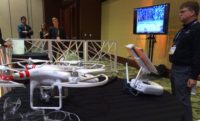When reading the news it seems developers, architects, engineers and contractors are fascinated with using unmanned aircraft on their next big project. And legally, any of them can fly a drone for recreational purposes within his or her field of vision and at a height of no more than 400 feet above ground provided they are not in restricted areas like airports or government installations like the White House. But whenever they step into the commercial space, new rules apply; and to avoid large fines here’s some advice.
The Federal Aviation Administration (FAA) considers UAVs as aircraft and that classification is used to determine how to regulate this technology. The FAA implemented a system for drone owners on December 21, 2015, to register both recreational and commercial aircraft. Since that time all drones must be registered with the FAA after purchase. Failure to do could result in criminal penalties up to $250,000 fine and up to three years in prison, according to a ruling by the FAA.
Registering a sub-55-pound drone isn’t difficult, even if it’s carrying cameras or some other form of payload. Owners can go to the FAA website, provide their name, address, and email address, and obtain a Certificate of Aircraft Registration that includes a unique identification number that must be marked on the aircraft. At this time, the cost is only $5 and registration is good for three years. Note that if your aircraft is over 55 pounds, you must register it via a paper process and obtain specific approval from the FAA.
If drone usage goes outside of these guidelines, owners will need to work with the FAA directly to obtain exceptions. Some states and municipalities maintain their own laws regarding the use of UAVs for both commercial and recreational purposes.
Over the next decade drones will likely become an indispensable part of an architect or engineer's tool kit. If a decision is made to move forward with the use of drones, be aware of the liability issues. A wayward drone can cause both physical injury and property damage. Therefore, check your commercial general liability policy (CGL) to see whether the use of a drone would be covered.
Most CGL policies specifically exclude liability that arises out of the ownership, maintenance or use of aircraft. Work with your agent to determine the exact language of your policy and whether a drone would be classified as aircraft. Some insurance carriers are now offering endorsements to their general liability and umbrella policies to include the risks of drones. If the carrier is unable or unwilling to provide an endorsement, you may need to purchase a separate UAV policy to get the coverage you need.
Also, professional liability issues could crop up with the use of a drone. Failure to perform up to the current standard of care regarding the operation and application of the UAV and the accuracy, dissemination and use of the information gathered could lead to an errors and omissions claim. Again, some professional liability insurance carriers are on the forefront of the issue and including coverage for professional services related to drone usage. Check with your agent for more information.
Be aware of any sub consultants that may be utilizing drones as you could be vicariously liable for any claims that arise. Be sure to check the sub consultant’s coverage amounts and obtain certificates of insurance proving coverage. If the sub's insurance is inadequate, touch base with your agent to make sure your firm is adequately covered in the event a drone claim arises and you’re pulled into the dispute.
The Professional Liability Agents Network (PLAN) may be able to help you by providing referrals to consultants, and guidance relative to insurance issues, and even to certain preventives, from construction observation through the development and application of sound human resources management policies and procedures.
Even with the regulations that must be met, drones offer true business advantages, including savings in time and money and increased safety when compared with the alternatives, such as manned helicopters and small planes. With a small, lightweight and relatively inexpensive drone equipped with a digital camera, Wi-Fi and a GPS, firms can map out large job sites or completed projects in great detail within an hour.
Drones provide a low bar of entry for capturing an aerial view of undeveloped land, hazardous conditions, active building sites, finished projects (both interior and exterior) and all steps in between. This allows design firms to provide their clients and their project managers with extremely accurate visual representations of a project. Those representations can include photos, videos, thermal readings, infrared scans, 3D topography models and other data that can be imported into a design firm's or a client's computer using standard design software programs.
From initial land surveying through final project walk-throughs, drones are amazing tools that promise increased efficiency and effectiveness in serving client needs. Indeed drones raised the bar for the types of services and data clients expect from their designers and contractors.
Jeff Cavignac, is president and principal of Cavignac & Associates, a member of PLAN and a leading commercial insurance brokerage firm providing a broad range of insurance and expertise to design and construction firms, law firms, real estate-related entities, manufacturing companies and the general business community.




Post a comment to this article
Report Abusive Comment